The Young Foxes and the Wise Owl
Once upon a time, two young foxes, Zuri and Nico, heard rumors about the Wise Owl, known for having "the answer to everything." Curious, they decided to visit him.
When they arrived at the great oak tree where he lived, they said:
—Wise Owl, please teach us the answer to everything!
The Owl, his eyes gleaming under the moonlight, replied:
—The answer to everything lies in this riddle: "What can be found in every step and never ends?"
Zuri, impatient, said:
—This will be easy! —and dashed off to find the quickest answer.
Nico, calmer, chose to walk through the forest, observing everything along the way.
Zuri asked all the animals:
—Do you know the answer to the Owl’s riddle?
But their answers were confusing, and the more he asked, the more frustrated he became.
Meanwhile, Nico noticed how the dew sparkled on the leaves, listened to the whisper of the wind, and helped a rabbit find its burrow. Each experience made him think more deeply about the riddle.
When the two foxes returned to the Owl, Zuri was exhausted and still had no answer. Nico, however, was smiling brightly.
—Did you solve it? —asked the Owl.
—Yes, Nico replied. —The answer is learning. There’s always something to learn in every step we take, and that never ends.
The Owl nodded, pleased. Zuri sighed and, this time, paid close attention.
Moral: True wisdom isn’t about knowing everything but about learning along the way.
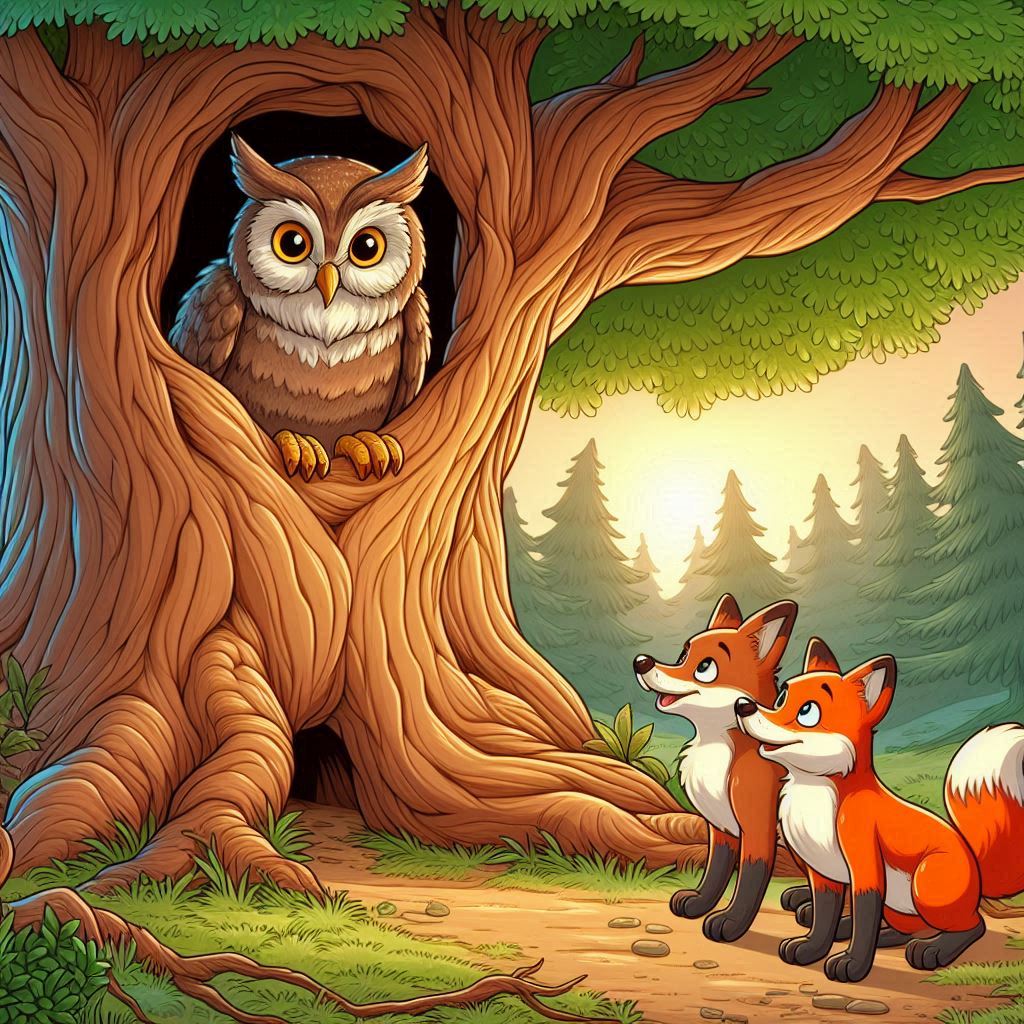
Instructions: Look for the Spanish meaning of the following words and drag each word to its correct meaning.
Words
Meanings
(Interactive feature: Words can be dragged and dropped to match meanings. Once matched correctly, the words flash green.)
Instructions: Read the sentences below. Decide if each one is true or false. Click on the correct option.
1. Zuri wanted to find the answer quickly.
2. Nico stayed calm and observed the forest.
3. The Wise Owl gave the foxes the answer right away.
4. Zuri solved the riddle before Nico.
5. The riddle's answer was “learning.”
Objective: Arrange the events of the story in the correct order to reveal the moral.
Play MinigameHabía una vez, dos jóvenes zorros, Zuri y Nico, que escucharon rumores sobre el sabio Búho, conocido por tener “la respuesta a todo”. Curiosos, decidieron visitarlo.
Cuando llegaron al gran roble donde vivía, le pidieron:
—Sabio Búho, ¡enséñanos la respuesta a todo!
El Búho, con sus ojos brillando bajo la luz de la luna, les dijo:
—La respuesta a todo está escondida en este acertijo: "¿Qué se puede encontrar en cada paso y nunca se acaba?"
Zuri, impaciente, dijo:
—¡Esto será fácil! —y salió corriendo a buscar la respuesta más rápida.
Nico, más tranquilo, decidió caminar por el bosque y observar todo con calma.
Zuri preguntó a todos los animales:
—¿Sabes la respuesta al acertijo del Búho?
Pero las respuestas eran confusas, y cuanto más preguntaba, más frustrado se sentía.
Mientras tanto, Nico miraba cómo brillaban las gotas de rocío en las hojas, escuchaba el susurro del viento y ayudaba a un conejo a encontrar su madriguera. Cada experiencia le hacía pensar más profundamente sobre el acertijo.
Cuando ambos zorros regresaron al Búho, Zuri estaba agotado y aún sin respuesta. Nico, en cambio, tenía una gran sonrisa.
—¿La has resuelto? —preguntó el Búho.
—Sí —respondió Nico—. La respuesta es el aprendizaje. Siempre hay algo que aprender en cada paso que damos, y eso nunca se acaba.
El Búho asintió, satisfecho. Zuri suspiró y, esta vez, escuchó con atención.
Moraleja: La verdadera sabiduría no está en saberlo todo, sino en aprender del camino.
The Fish Who Learned to Flow
In a clear, lively river full of fish swimming with the current, there lived Tilo, a young blue fish with a big idea: he wanted to be different. “I’m not like the others!” he said proudly as he practiced swimming against the current.
One day, while the other fish glided effortlessly, Tilo decided to prove he could swim the opposite way. At first, he felt strong, but soon his fins began to ache, and he ran out of energy. The current pushed him around, and he got caught in a whirlpool.
“Help!” cried Tilo, exhausted. That’s when Don Río, an old fish with silvery scales and a wise reputation, appeared. Calmly, he swam over and helped Tilo out of the whirlpool.
“What are you doing here, young one?” asked Don Río.
“I wanted to be different… to swim against the current,” Tilo replied, gasping.
Don Río smiled. “Being different doesn’t mean fighting everything. If you struggle without understanding the river, you’ll only tire yourself out and get lost.”
“So, what should I do?” Tilo asked.
“Learn to use the current to your advantage,” said the old fish. “The river isn’t your enemy; it’s a path. Watch: if you follow its twists and turns, you can go farther and save your strength.”
Don Río showed Tilo how to move with the currents, how to glide smartly, and how to use the river’s power to reach his goals faster.
From that day on, Tilo understood that being true to himself didn’t mean fighting everything. And while he stayed unique, he learned that flowing with the river sometimes took him farther than swimming against it.
Moral: Being yourself doesn’t always mean going against the flow—it means learning to move wisely.
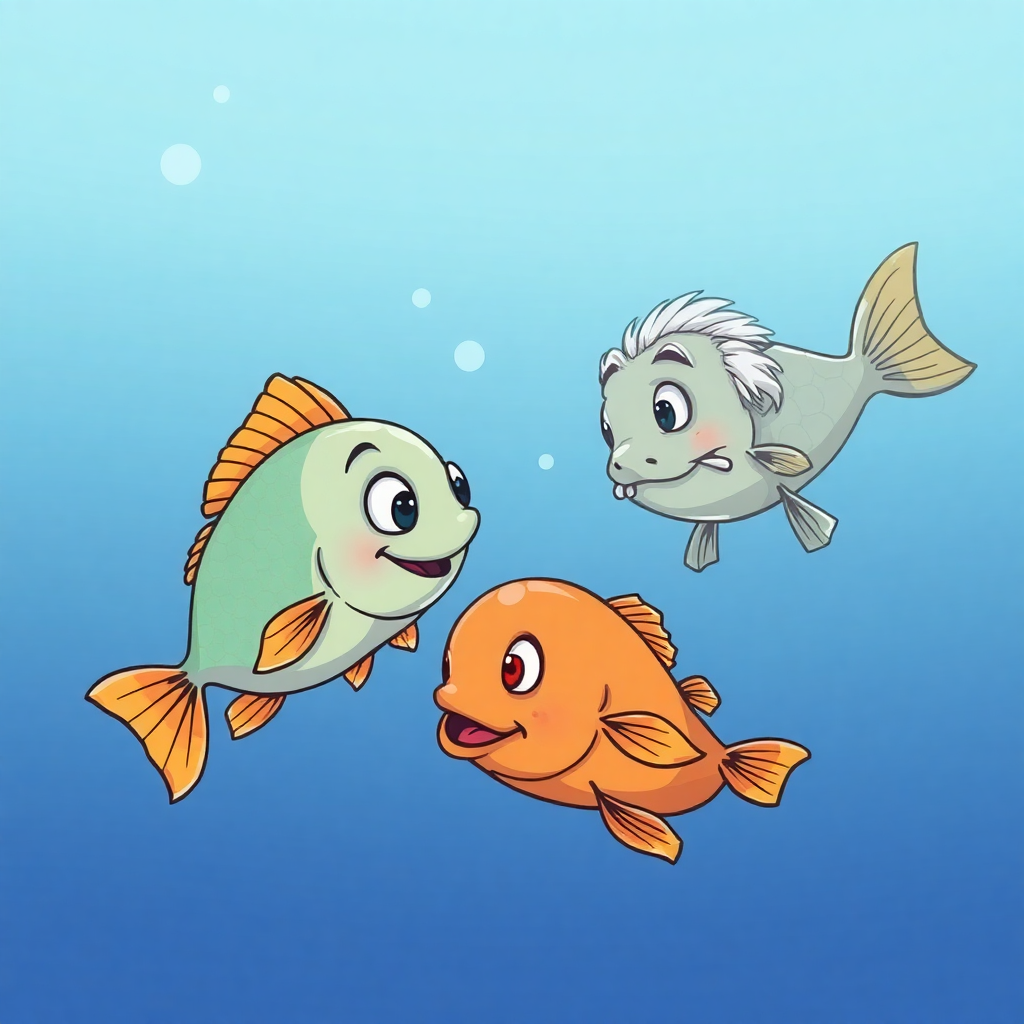
Instructions: Read the words in the box and match each word with its image. Click on the correct word and drag it to the corresponding image.
Drag the Images






Drop Here
- Current
- Fish
- Swim
- Energy
- Help
- River
Instructions: Read the fable and answer the following questions.
Objective: Reinforce the moral by guiding Tilo to use the current wisely.
Play MinigameEn un río cristalino, lleno de peces que nadaban juntos siguiendo la corriente, vivía Tilo, un joven pez azul con una gran idea: quería ser diferente. "¡Yo no soy como los demás!", decía orgulloso mientras practicaba nadar contra la corriente.
Un día, mientras los otros peces se deslizaban con facilidad, Tilo decidió demostrar que podía ir en dirección contraria. Al principio, se sintió fuerte, pero pronto sus aletas comenzaron a doler y su energía se agotó. La corriente lo empujó de un lado a otro, y terminó atrapado en un remolino.
"¡Ayuda!", gritó Tilo, exhausto. Fue entonces cuando apareció Don Río, un viejo pez de escamas plateadas, conocido por su sabiduría. Con calma, nadó hasta Tilo y lo empujó fuera del remolino.
"¿Qué haces aquí, jovencito?", preguntó Don Río.
"Quería ser diferente... nadar contra la corriente", respondió Tilo, jadeando.
Don Río sonrió. "Ser diferente no significa ir en contra de todo. Si luchas sin entender el río, solo te cansarás y te perderás".
"¿Entonces, qué hago?", preguntó Tilo.
"Aprende a usar la corriente a tu favor", dijo el viejo pez. "El río no es tu enemigo; es un camino. Mira: si te deslizas con sus giros, puedes avanzar más lejos y ahorrar energía".
Don Río le enseñó a moverse entre las corrientes, a deslizarse con inteligencia y a aprovechar su fuerza para llegar más rápido a donde quería ir.
Desde ese día, Tilo entendió que ser auténtico no era pelear contra todo, sino moverse con astucia. Y aunque seguía siendo único, aprendió que, a veces, fluir con el río lo llevaba más lejos que nadar contra él.
Moraleja: Ser auténtico no siempre es ir contra la corriente, sino aprender a moverte con inteligencia.
The Monkey and the Stubborn Tree
Once upon a time, a monkey named Nico lived in a tree that no longer gave fruit. Even though food was scarce, Nico refused to leave.
"This tree knows me. I’m safe here," he said, even as his stomach rumbled.
One day, his friend Lila the squirrel came hopping by.
"Nico, we’ve found a forest full of sweet fruits and nuts!" she announced excitedly.
"Move? That’s crazy!" Nico replied, clinging tightly to a branch.
But as days went by, hunger grew stronger. The other animals were happy in their new home, while Nico kept trying to squeeze something out of a stubborn old tree that wouldn’t even drop a leaf.
Finally, one quiet afternoon, with an empty stomach and a heavy heart, Nico looked around. The forest felt lonelier without his friends.
“Maybe... just maybe...” he whispered.
With a brave leap, he left the tree and began to explore. At first, every step filled him with doubt, but soon, the air filled with new scents: ripe fruits, fresh flowers, and crunchy leaves.
When Nico reached the new forest, his friends greeted him with hugs and laughter. There, he found a big tree full of juicy fruit that seemed to say, “Welcome home.”
That night, as he ate happily, Nico realized something important:
"Change is scary, but sometimes it’s the best thing that can happen to us."
From that day on, Nico never let fear keep him stuck in one place.
Moral: Change can be hard, but it’s necessary to grow.
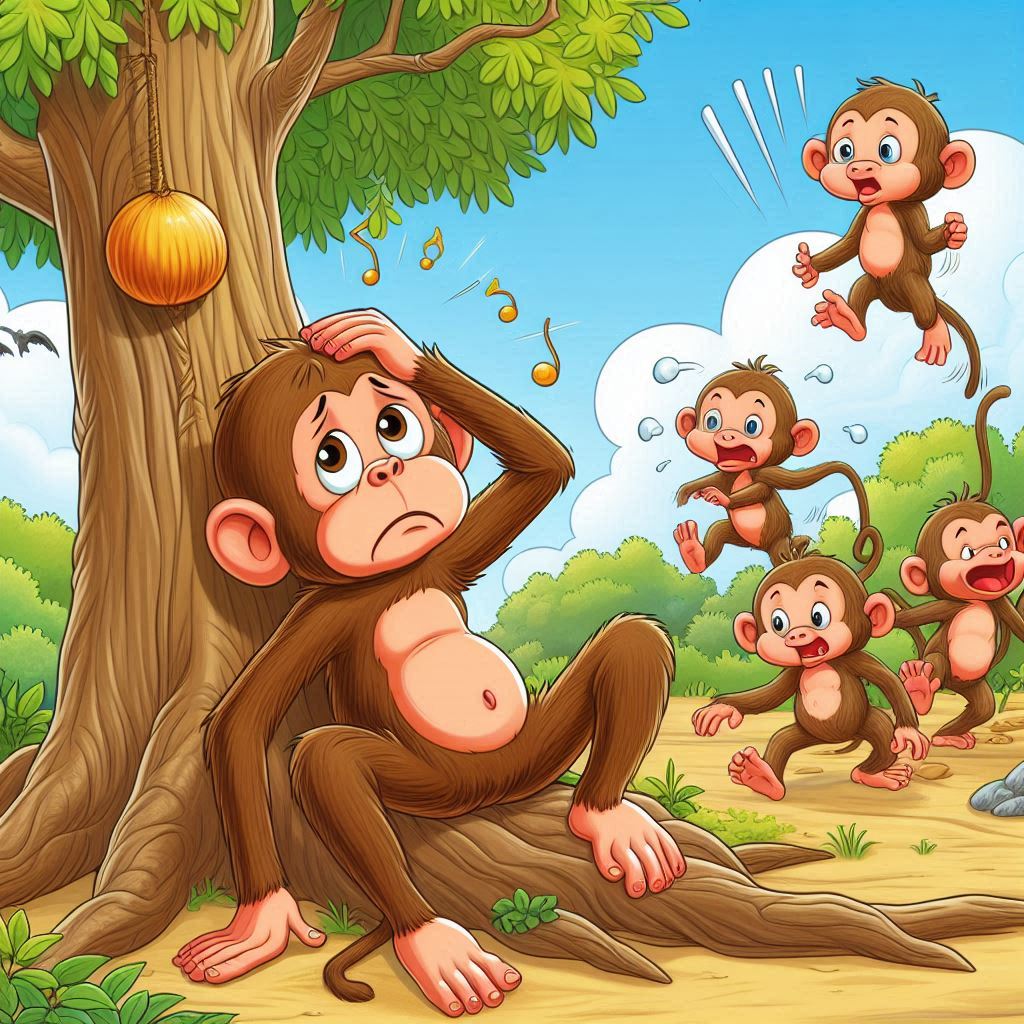
Instructions:
- Select the GREEN or RED pencil.
- Click on the words to color them accordingly.
Words:
- Change
- Friend
- Hungry
- Brave
- Alone
Fun Tip: Say each word out loud while you color!
Objective: Understand the main ideas of the story.
Instructions: Read the sentences below and decide if they are true or false. Select your answer from the dropdown list.
Objective: Complete the puzzle and discover the scene of the fable.
Play MinigameHabía una vez un mono llamado Nico que vivía en un árbol que ya no daba frutos. Aunque la comida escaseaba, Nico se negaba a mudarse.
—Este árbol me conoce, aquí estoy seguro —decía mientras escuchaba el crujir de sus tripas.
Un día, su amiga Lila la ardilla pasó brincando.
—¡Nico, hemos encontrado un bosque lleno de frutas dulces y nueces! —anunció con emoción.
—¿Mudarse? ¡Qué locura! —respondió Nico, aferrándose a una rama.
Pero, a medida que pasaban los días, el hambre apretaba. Los otros animales estaban felices en su nuevo hogar, mientras Nico seguía intentando arrancar algo de un árbol viejo y testarudo que no cedía ni una hoja.
Finalmente, una tarde, con el estómago vacío y el corazón temblando, Nico miró a su alrededor. El bosque parecía más silencioso sin sus amigos.
—Tal vez... solo tal vez... —susurró.
Con un salto decidido, dejó el árbol y comenzó a explorar. Al principio, cada paso lo llenaba de dudas, pero pronto el aire se llenó de nuevos aromas: frutas maduras, flores frescas y hojas crujientes.
Cuando llegó al nuevo bosque, sus amigos lo recibieron con abrazos y risas. Ahí encontró un árbol grande y lleno de frutos jugosos, que parecía decirle: —Bienvenido a casa.
Esa noche, mientras cenaba feliz, Nico comprendió algo importante:
—El cambio da miedo, pero a veces es lo mejor que nos puede pasar.
Desde entonces, Nico nunca volvió a quedarse atrapado en un lugar por miedo.
Moraleja: El cambio puede ser difícil, pero es necesario para crecer.
The Lion and the Squirrel
In a forest deep, where trees grow tall, a lion roars, mighty and all. He walks with pride, his head held high, while a small squirrel watches from nearby.
One day, the lion got caught in a net, trapped and tangled, he could not forget. He roared and struggled, but it was in vain, his strength was no match for the chains.
The little squirrel, so light and quick, ran to the lion with a clever trick. With tiny teeth, she gnawed through the rope, and set the lion free, giving him hope.
"Thank you, little friend," the lion said, "Your kindness is greater than my strength, instead." The squirrel smiled, so wise and small, "Sometimes, the smallest help can save us all."
Moral: Kindness can come from the smallest of creatures.

Instructions: Complete the sentences using the words from the vocabulary list.
- 1. The roared loudly in the jungle.
- 2. The has a fluffy tail and loves to climb trees.
- 3. A is full of trees and animals.
- 4. The lion was proud of his great .
- 5. After the trap was broken, the lion was finally .
- 6. The lion was in the net and couldn't move.
- 7. It was her that helped him escape.
- 8. Even though the squirrel was , she saved the day.
Objective: Understand the main ideas of the story.
Instructions: Read the questions below and select the correct answer.
Objective: Complete the puzzle and discover the scene of the fable.
Play MinigameEn un bosque hondo, de árboles altos, ruge un león, fuerte y osado. Camina altivo, con gran esplendor, mientras lo observa una ardilla.
Un día el león cayó en un lazo, atrapado y preso en un cruel abrazo. Rugió y luchó con todo su ardor, mas no pudo romper su atador.
La ardilla, ágil y ligera, corrió hacia él con idea certera. Con dientes pequeños, la soga roció, y liberó al gran león.
“Gracias, amiga,” el león declaró, “Tu bondad mi fuerza superó.” La ardilla sonrió, sabia y sutil: “A veces, lo pequeño puede salvarte a ti.”
Moraleja: La bondad puede venir de los más pequeños.
The Tortoise and the Hare
The hare was fast, the best in the race, he bragged and laughed, always first in place. The tortoise, slow, with her steady pace, was often teased, yet kept her grace.
One day, the hare challenged the tortoise to run, "I'll win so easily, this will be fun!" The tortoise agreed, calm and serene, "I’ll race you, my friend, though I’m slow and lean."
The race began, and the hare sped fast, soon out of sight, the tortoise lagged last. But the hare, so confident and quick, stopped to rest, feeling safe and slick.
Meanwhile, the tortoise, with patience and care, plodded along, not rushing anywhere. By the time the hare woke up from his nap, the tortoise had won, closing the gap.
"Slow and steady wins the race," she said, while the hare hung his head.
Moral: Pride and haste often cause the fall.
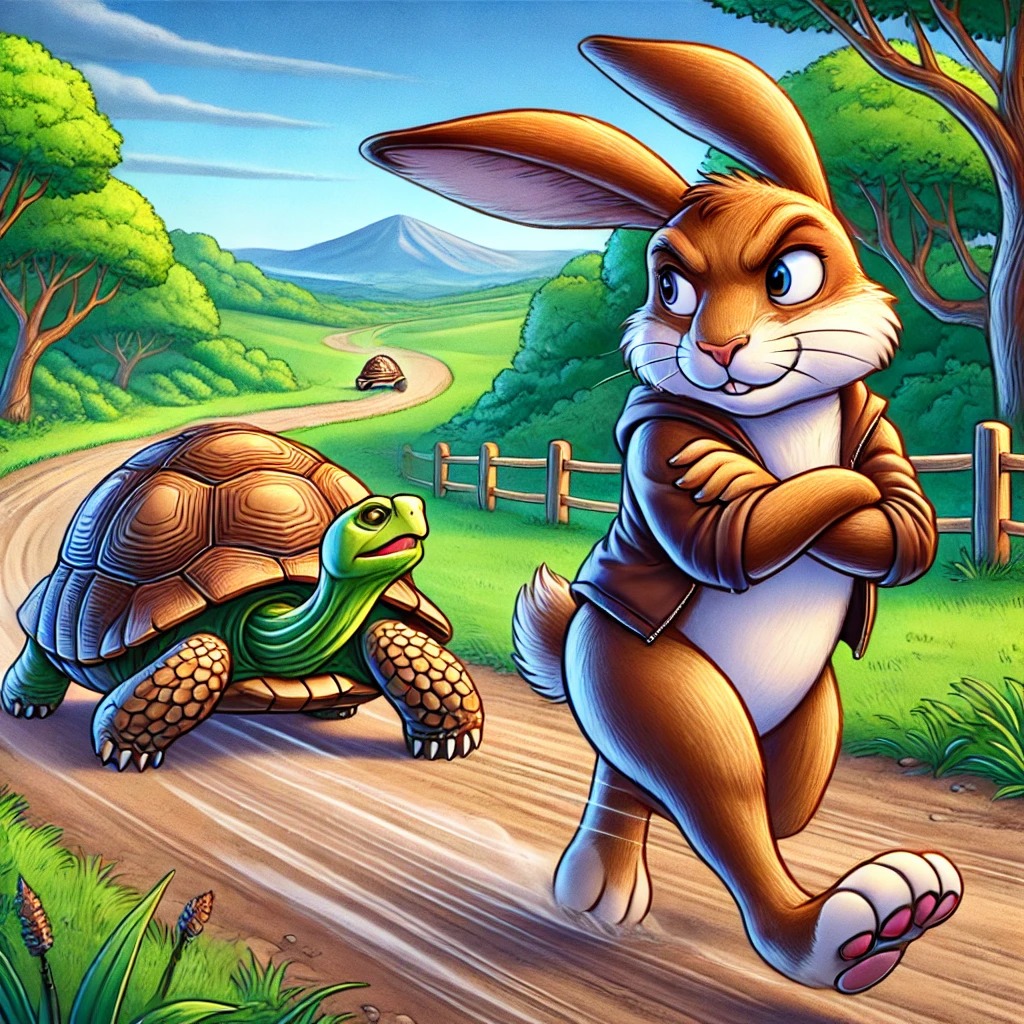
- Hare
- Tortoise
- Race
- Fast
- Slow
- Rest
- Steady
- Patience
Instructions: Read the questions and choose the correct answer.
- What was the hare's attitude before the race?
- Why did the hare lose the race?
- What is the moral of the story?
- Who won the race?
Objective: Test your knowledge of the story with this interactive game.
Play MinigameLa liebre era rápida, la mejor en la carrera, se burlaba y reía, siempre primera. La tortuga, lenta, con paso constante, soportaba bromas, siempre elegante.
Un día, la liebre la quiso retar: "Te ganaré fácil, me voy a burlar." La tortuga, serena, aceptó el desafío: "Correré contigo, despacio pero fijo."
La carrera empezó y la liebre voló, pronto se alejó, la tortuga se quedó atrás. Pero confiada y llena de orgullo, la liebre durmió con aire seguro.
Mientras, la tortuga, con gran paciencia, avanzó sin prisa, con resistencia. Cuando la liebre al fin despertó, la tortuga ya había cruzado la meta.
"Lento y firme se gana al final," dijo la tortuga con tono cordial. Bajó la cabeza la liebre vencida, aprendiendo la lección de por vida.
Moraleja: El orgullo y la prisa a menudo causan la caída.
The Fox and the Grapes
A hungry fox, with fur so sleek, walked through the vineyard, feeling weak. He looked up high, and there, in sight, were bunches of grapes, hanging tight.
He jumped and jumped, but couldn’t reach, the grapes were just beyond his speech. He tried once more, with all his might, but still the grapes stayed out of sight.
"Those grapes are sour," he finally cried, "And not worth the trouble, no need to hide!" So off he walked, with head held high, pretending that he didn’t want the prize.
Moral: Sometimes, when we fail, we act with glee. What we can’t have, we may despise, to ease the sting of our own lies.
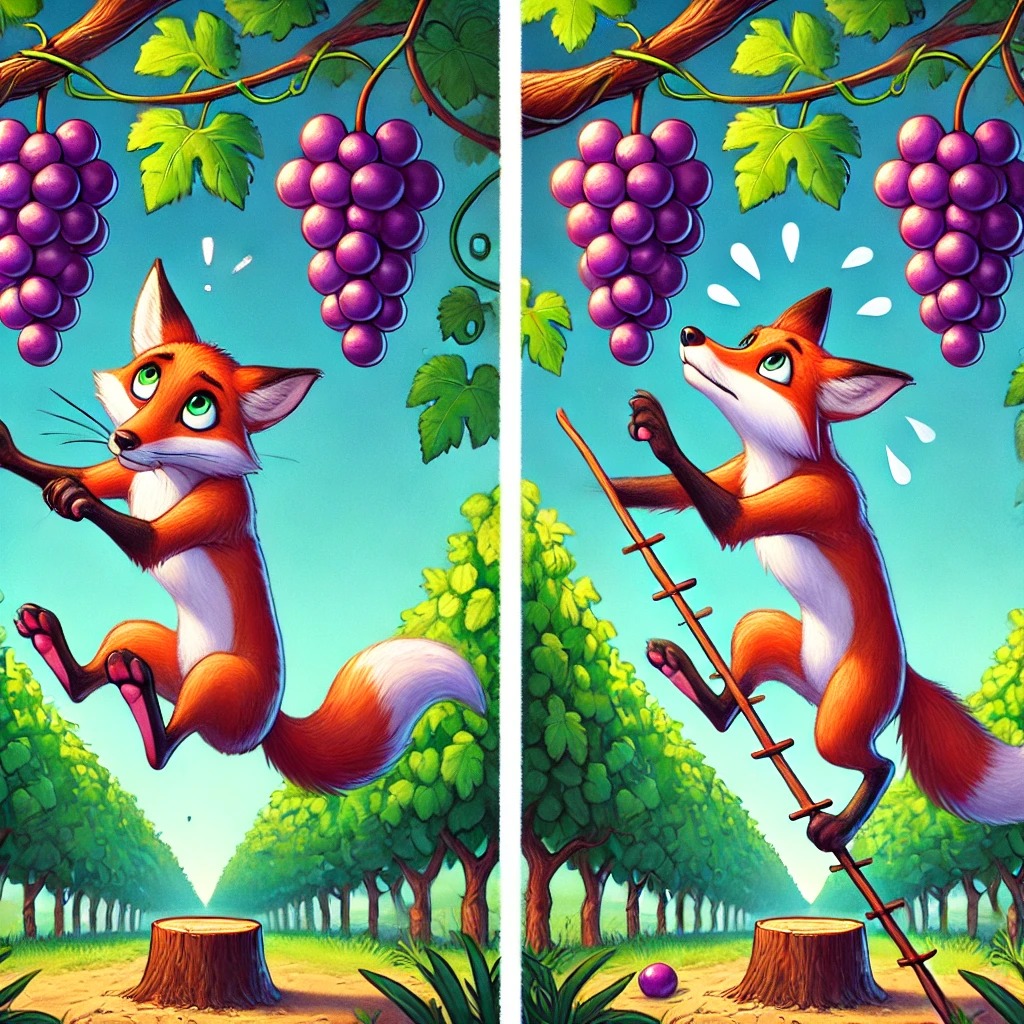
Vocabulary List:
- Fox
- Grapes
- Vineyard
- Hungry
- Jumped
- Sour
- Tried
- Pretending
Objective: Understand the main ideas of the story.
Instructions: Read the questions below and select the correct answer.
Objective: Complete the puzzle and discover the scene of the fable.
Play MinigameUn zorro hambriento, ágil y astuto, cruzó un viñedo con paso enjuto. Alzó la vista y pudo observar racimos de uvas en lo alto brillar. Saltó y saltó, mas no alcanzó, las uvas siempre lejos quedaron. Probó de nuevo con gran afán, pero el fruto siguió más allá.
"Son uvas agrias," al fin exclamó, "no valen el esfuerzo, mejor me voy yo." Se alejó erguido, con falso desdén, fingiendo que nunca las quiso tener.
Moraleja: Cuando algo no podemos lograr, a veces fingimos no desear, para así nuestro orgullo salvar.
The Fox and the Clever Rabbit
Once, a hungry fox saw a little rabbit in the forest. The fox said, “Little rabbit, I am hungry. I will eat you!” The rabbit was scared, but she had an idea. She said, “Wait, Mr. Fox! I know where you can find bigger, tastier food.”
The fox stopped. “Bigger food? Show me!” he said. The rabbit led the fox to a big pond. “Look into the water,” said the rabbit. The fox saw his own reflection. He thought it was another fox. “That fox looks big and strong. I will eat him!” said the fox.
The fox jumped into the water to catch the “big fox,” but there was no one there! He got wet and cold, and the rabbit ran away. The fox learned a lesson: Don’t be greedy, or you might lose everything.
Moral: Greed can lead to losing what you already have.
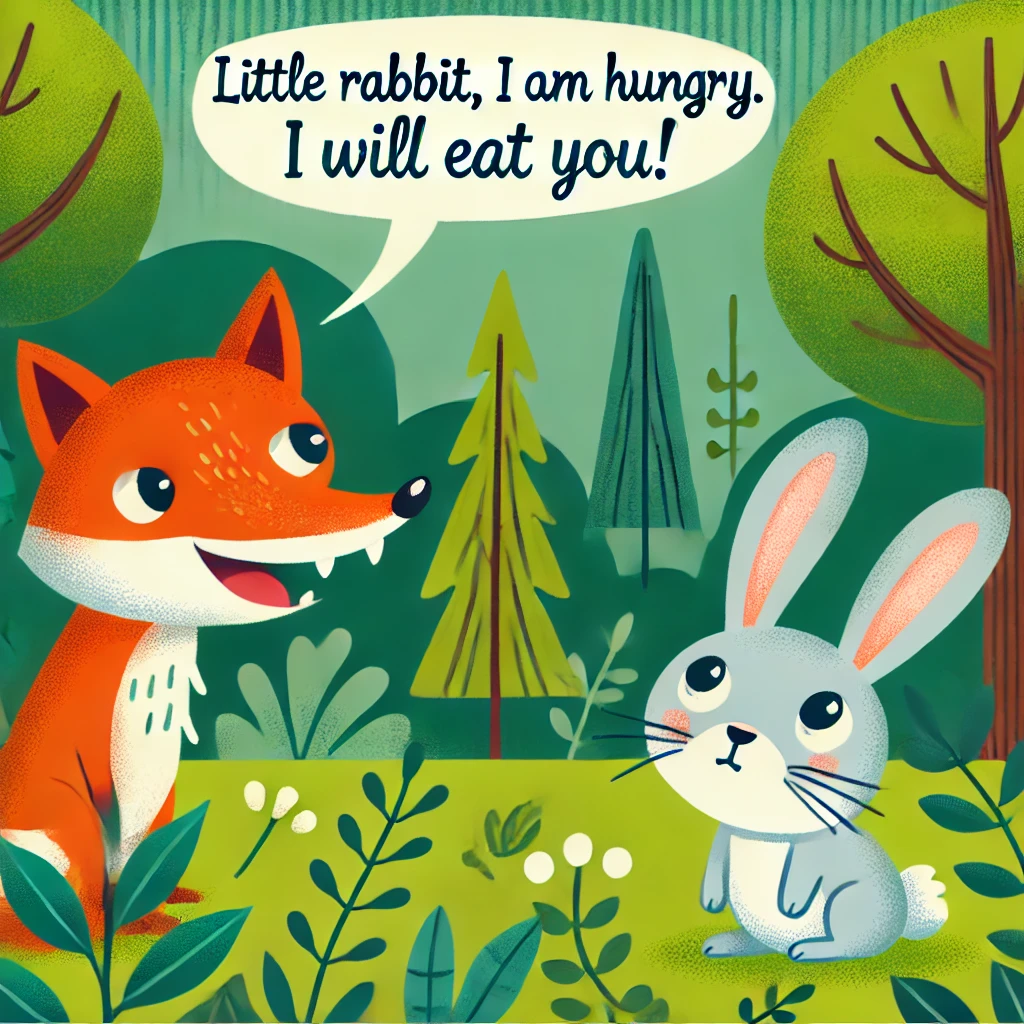
Vocabulary List:
- Fox - Zorro
- Rabbit - Conejo
- Pond - Estanque
- Hungry - Hambriento
- Scared - Asustado
Instruction: Choose the correct answer.
Instruction: Create an interactive game where students sort the parts of the story. Use a platform like Wordwall or Kahoot to design a drag and drop exercise.
Play MinigameUn día, un zorro hambriento vio a un pequeño conejo en el bosque. El zorro dijo: “Conejo, tengo hambre. ¡Te voy a comer!” El conejo tenía miedo, pero tuvo una idea. “Espera, señor Zorro. Sé dónde puedes encontrar comida más grande y deliciosa”, dijo.
El zorro se detuvo. “¿Comida más grande? ¡Muéstramela!” dijo. El conejo llevó al zorro a un gran estanque. “Mira en el agua”, dijo el conejo. El zorro vio su propio reflejo. Pensó que era otro zorro. “Ese zorro parece grande y fuerte. ¡Voy a comerlo!” dijo el zorro.
El zorro saltó al agua para atrapar al “gran zorro”, pero no había nadie allí. ¡Se mojó y tuvo frío, mientras el conejo corrió lejos! El zorro aprendió una lección: no seas codicioso o podrías perderlo todo.
Moraleja: La codicia puede hacerte perder lo que ya tienes.
The Lazy Ant and the Busy Bee
One sunny day, a lazy ant sat under a tree. She saw a bee flying and working hard. The ant said, “Bee, why do you work so much? Let’s rest and enjoy the sun!” The bee smiled and said, “I need to gather food for winter.”
The ant laughed. “Winter is far away! You don’t need to work now,” she said. But the bee kept flying and collecting food.
When winter came, the ant was cold and hungry. She had no food. The bee stayed warm in her hive with plenty to eat. The ant learned a lesson: Work hard today to be ready for tomorrow.
Moral: Preparation today ensures comfort tomorrow.
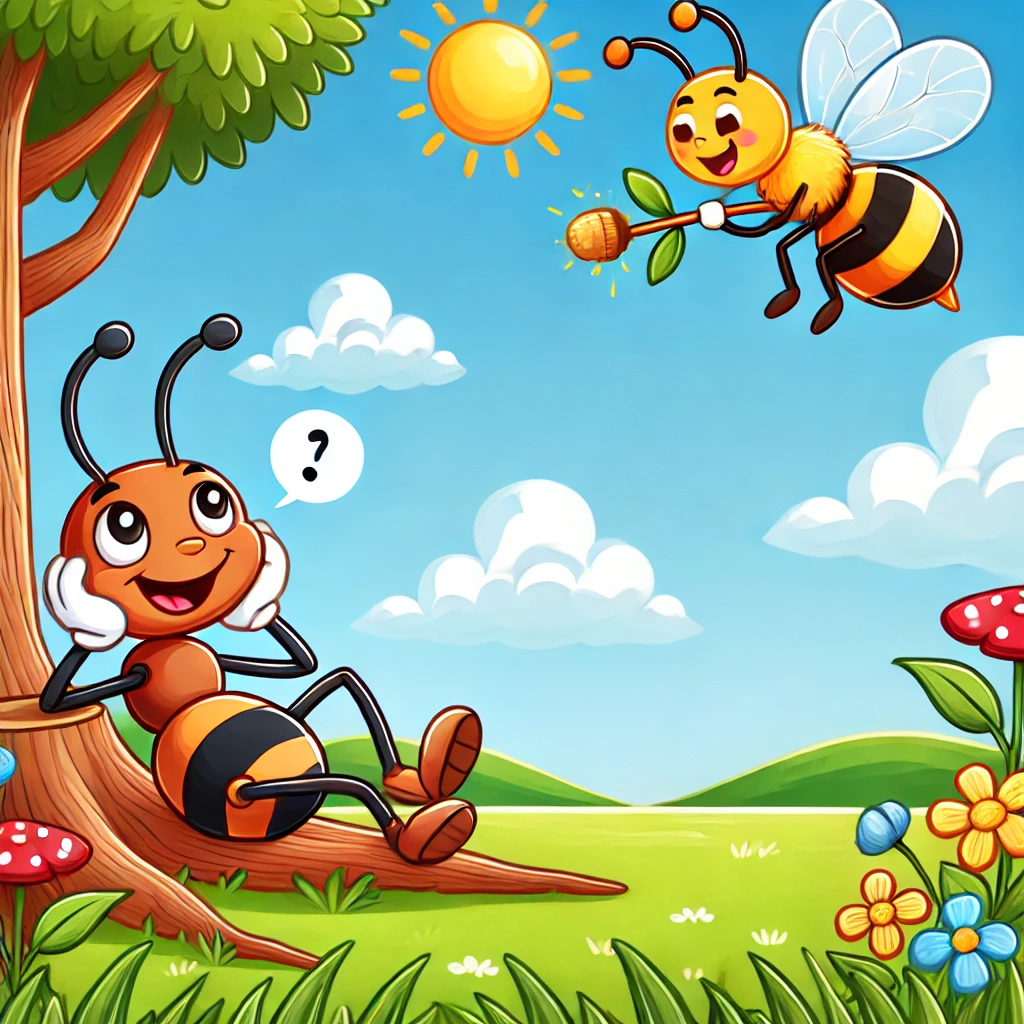
Vocabulary List:
- Ant - Hormiga
- Bee - Abeja
- Sunny - Soleado
- Winter - Invierno
- Food - Comida
Instruction: Create an interactive game in Wordwall or Kahoot to sort the parts of the story.
Play MinigameUn día soleado, una hormiga perezosa estaba sentada bajo un árbol. Vio a una abeja volando y trabajando mucho. La hormiga dijo: “Abeja, ¿por qué trabajas tanto? ¡Descansemos y disfrutemos el sol!” La abeja sonrió y dijo: “Necesito recolectar comida para el invierno”.
La hormiga se rió. “¡El invierno está muy lejos! No necesitas trabajar ahora”, dijo. Pero la abeja siguió volando y recolectando comida.
Cuando llegó el invierno, la hormiga tenía frío y hambre. No tenía comida. La abeja estaba cálida en su colmena con mucha comida. La hormiga aprendió una lección: Trabaja duro hoy para estar listo mañana.
Moraleja: Prepararse hoy asegura el bienestar de mañana.
The Turtle and the Fast Fish
A turtle was swimming slowly in the river. A fast fish swam by and laughed at her. “You are so slow! I can swim faster than you,” said the fish. The turtle smiled and said, “That’s true, but being fast is not always the best.”
The fish challenged the turtle to a race. “Let’s race to the big rock,” said the fish. The turtle agreed. The fish swam fast, but he didn’t see a fishing net in the water. He got caught! The turtle swam slowly and safely to the rock.
The fish asked for help, and the turtle freed him. The fish learned a lesson: Slow and careful can be better than fast and careless.
Moral: Patience and caution often lead to better outcomes.
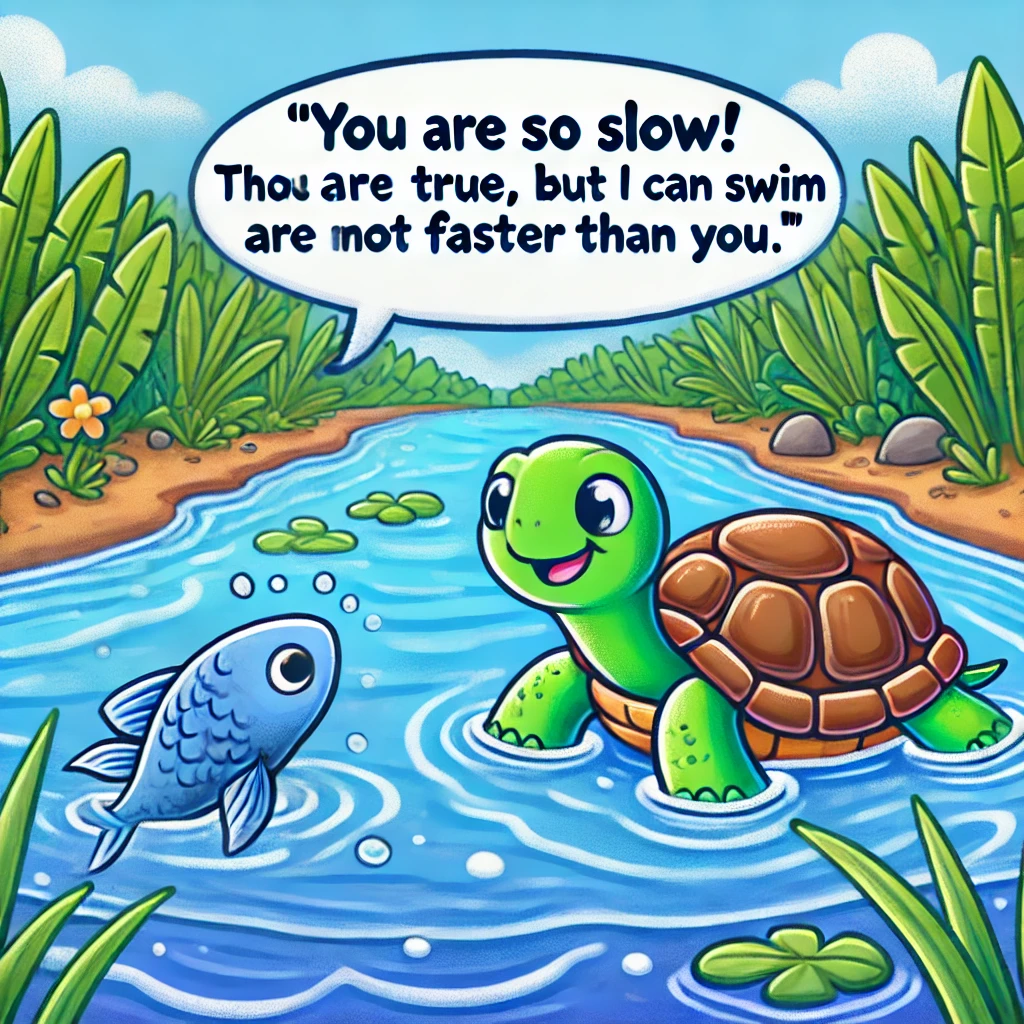
Vocabulary List:
- Turtle - Tortuga
- Fish - Pez
- River - Río
- Fast - Rápido
- Slow - Lento
Instruction: Create an interactive game in Wordwall or Kahoot to sort the parts of the story.
Play MinigameUna tortuga nadaba lentamente en el río. Un pez rápido pasó nadando y se rió de ella. “¡Eres muy lenta! Yo puedo nadar más rápido que tú”, dijo el pez. La tortuga sonrió y dijo: “Es cierto, pero ser rápido no siempre es lo mejor”.
El pez retó a la tortuga a una carrera. “Corramos hasta la gran roca”, dijo el pez. La tortuga aceptó. El pez nadó rápido, pero no vio una red de pesca en el agua. ¡Quedó atrapado! La tortuga nadó lenta y segura hasta la roca.
El pez pidió ayuda, y la tortuga lo liberó. El pez aprendió una lección: Ser lento y cuidadoso puede ser mejor que rápido y descuidado.
Moraleja: La paciencia y la precaución suelen llevar a mejores resultados.
The Bird and the Cat
Once upon a time, a small bird loved to sing high in the trees. She sang every morning, her bright feathers shining in the sun. The bird was very happy, but she always looked down at the ground and saw a cat watching her. The cat had sharp eyes and a quiet smile.
One day, the bird decided to fly lower. She thought, "Maybe the cat just wants to be my friend." She flew down to a branch near the ground and began to sing.
The cat slowly walked closer and said, "Hello, little bird. You sing so beautifully! I think you must be very tasty, too."
The bird stopped singing and looked worried. "Tasty? What do you mean?" she asked.
The cat smiled and said, "You are small, and I am hungry. I could catch you if you stay close to me."
The bird quickly flew back up into the tree, her heart beating fast. "I made a mistake," she thought. "Not all animals want to be friends."
From that day, the bird stayed high in the trees, singing from far away where the cat could not reach her. The cat learned that if he wanted to hear the bird sing, he had to let her be free. And the bird learned that not everyone who looks at you is a friend.
Moral: Stay safe and trust your instincts. Not all attention is kind.
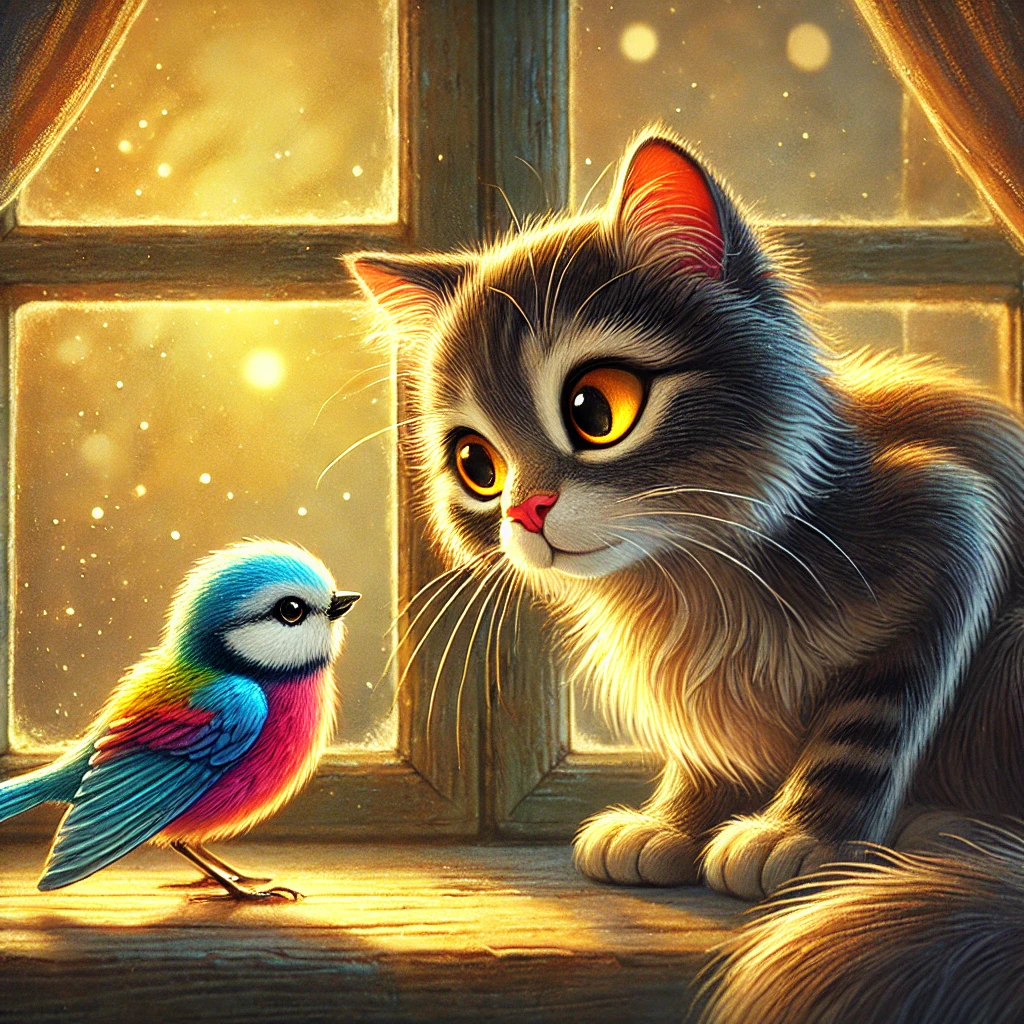
Vocabulary List:
- Friend - Amigo
- Flew - Voló
- Sharp - Afilado
- Tasty - Sabroso
- Free - Libre
Instruction: Create an interactive game in Wordwall or Kahoot to sort the parts of the story.
Play MinigameHabía una vez un pequeño pájaro que amaba cantar alto en los árboles. Cantaba todas las mañanas, con sus brillantes plumas brillando al sol. El pájaro era muy feliz, pero siempre miraba hacia abajo y veía a un gato mirándola. El gato tenía ojos afilados y una sonrisa tranquila.
Un día, el pájaro decidió volar más bajo. Pensó, "Tal vez el gato solo quiera ser mi amigo." Voló hasta una rama cerca del suelo y comenzó a cantar.
El gato caminó lentamente hacia ella y dijo, "Hola, pequeño pájaro. ¡Cantas tan bonito! Creo que también debes ser muy sabrosa."
El pájaro dejó de cantar y se mostró preocupada. "¿Sabrosa? ¿Qué quieres decir?" preguntó.
El gato sonrió y dijo, "Eres pequeña y yo tengo hambre. Podría atraparte si te quedas cerca de mí."
El pájaro rápidamente voló de nuevo hacia el árbol, su corazón latiendo rápido. "Cometí un error," pensó. "No todos los animales quieren ser amigos."
Desde ese día, el pájaro se quedó alto en los árboles, cantando desde lejos, donde el gato no podía alcanzarla. El gato aprendió que si quería escuchar al pájaro cantar, tenía que dejarla ser libre. Y el pájaro aprendió que no todos los que te miran son amigos.
Moraleja: Mantente a salvo y confía en tus instintos. No toda la atención es amable.
The Lion and the Tiger
Once upon a time, in a big forest, there lived a lion and a tiger. The lion was strong and proud, while the tiger was quick and clever. They often saw each other from far away but never spoke.
One day, the lion decided to walk through the forest and show everyone who was the strongest animal. He roared loudly, and all the animals scattered in fear. The tiger, who was nearby, heard the roar and thought, "Why does the lion have to be so loud? I am strong too, but I don't need to roar to prove it."
The next day, the tiger decided to show the lion how clever he was. He found a big rock and hid behind it. When the lion walked by, the tiger jumped out and scared him. The lion quickly turned around, ready to fight, but the tiger just laughed and ran away.
The lion felt embarrassed. "Why did the tiger do that?" he thought. "I am the king of the forest, but the tiger made me look foolish."
The next time they saw each other, the lion asked the tiger, "Why do you always try to outsmart me?"
The tiger smiled and said, "I don't want to outsmart you. I just want to show that being clever can be as important as being strong."
The lion thought for a moment and then said, "I see now. Strength is important, but so is being clever. We both have our own ways of being great."
From that day, the lion and the tiger respected each other. The lion kept his strength, and the tiger used his cleverness. They both understood that everyone has their own special qualities.
Moral: Strength and cleverness are both important. Everyone has their own unique talents.

Vocabulary List:
- Embarrassed - Avergonzado
- Strong - Fuerte
- Outsmart - Ser más astuto
- Foolish - Tonto
- Clever - Astuto
Instructions: Complete the sentences using the words from the vocabulary list.
- 1. I don't want to .
- 2. The lion was strong and proud, while the tiger was quick and .
- 3. The lion felt .
- 4. "I am the king of the forest, but the tiger made me look .
- 5. "I just want to show that being clever can be as important as being .
Instruction: Choose the correct answer.
- What were the strengths that the lion possesses that the tiger does not?
- What were the strengths that the tiger possesses that the lion does not?
- What was the lesson in the fable?
Instruction: Create an interactive game in Wordwall or Kahoot to sort the parts of the story.
Play MinigameHabía una vez, en un gran bosque, un león y un tigre. El león era fuerte y orgulloso, mientras que el tigre era rápido y astuto. A menudo se veían de lejos, pero nunca hablaban.
Un día, el león decidió caminar por el bosque y mostrarle a todos quién era el animal más fuerte. Rugió fuertemente, y todos los animales corrieron asustados. El tigre, que estaba cerca, escuchó el rugido y pensó: "¿Por qué el león tiene que ser tan ruidoso? Yo también soy fuerte, pero no necesito rugir para demostrarlo."
Al día siguiente, el tigre decidió mostrarle al león lo astuto que era. Encontró una gran roca y se escondió detrás de ella. Cuando el león pasó cerca, el tigre saltó y lo asustó. El león rápidamente dio vuelta, listo para pelear, pero el tigre solo se rió y corrió lejos.
El león se sintió avergonzado. "¿Por qué el tigre hizo eso?" pensó. "Soy el rey del bosque, pero el tigre me hizo parecer tonto."
La próxima vez que se vieron, el león le preguntó al tigre: "¿Por qué siempre intentas hacerme quedar mal?"
El tigre sonrió y dijo: "No quiero hacerte quedar mal. Solo quiero mostrar que ser astuto puede ser tan importante como ser fuerte."
El león pensó por un momento y luego dijo: "Ahora lo entiendo. La fuerza es importante, pero también lo es la astucia. Ambos tenemos nuestras propias maneras de ser grandes."
Desde ese día, el león y el tigre se respetaron. El león mantuvo su fuerza y el tigre usó su astucia. Ambos entendieron que cada uno tiene cualidades especiales.
Moraleja: La fuerza y la astucia son igual de importantes. Todos tienen talentos únicos.
The Friendship of Snow and Bamboo
Once upon a time, in a forest where the snow met the bamboo, there lived a panda bear named Pao and a polar bear named Arik. Pao loved the soft green bamboo shoots and the gentle rustle of the forest. Arik, on the other hand, preferred the icy winds and the quietness of the frozen sea.
One day, Arik wandered too far south, curious about the green trees he had heard about from migrating birds. He stumbled into Pao’s forest. Pao was sitting under a tall tree, happily munching on bamboo. When he saw Arik, he dropped his bamboo in surprise.
“Who are you?” Pao asked, his round eyes wide.
“I’m Arik, a polar bear. What is this place?” Arik replied, looking around in wonder.
“This is my forest,” Pao said, smiling. “Would you like to try some bamboo?”
Arik sniffed the bamboo but shook his head. “Thank you, but I prefer fish.”
Pao laughed. “Fish? I’ve never eaten one. What does it taste like?”
“Maybe I can show you if we find a stream,” Arik said. The two bears decided to explore together.
As they walked, Pao showed Arik the beauty of the forest—the chirping birds, the colorful flowers, and the tall trees. Arik marveled at everything. In return, Arik taught Pao how to fish in the stream. Though Pao was clumsy at first, he finally caught a small fish. He tasted it and wrinkled his nose.
“It’s not bad, but I think I’ll stick to bamboo,” Pao said, grinning.
“And I’ll stick to fish,” Arik replied with a chuckle.
The two bears spent the day sharing stories about their homes. Arik spoke of the shimmering northern lights and the endless ice, while Pao described the warmth of the forest and the peaceful sounds of nature. They realized their worlds were very different but equally beautiful.
When the sun began to set, Arik knew it was time to return to the cold north. “Thank you, Pao. I’ve learned so much today.”
“Me too,” Pao said. “You’re always welcome here, my friend.”
With a heavy heart but a warm smile, Arik left the forest, promising to visit again. From that day on, Pao and Arik stayed friends, teaching each other the value of curiosity and the joy of sharing.
And so, the panda bear and the polar bear proved that even the most different of creatures could find common ground and friendship.
Moral: Even the most different of creatures can find common ground and friendship.

Vocabulary List:
- Forest - Bosque
- Bamboo - Bambú
- Panda - Panda
- Ground - Terreno
- Fish - Pescado
Instructions: Complete the sentences using the words from the vocabulary list.
- 1. Pao loved the soft green shoots and the gentle rustle of the forest.
- 2. “This is my ,” Pao said, smiling.
- 3. Once upon a time, in a forest where the snow met the bamboo, there lived a bear named Pao and a polar bear named Arik.
- 4. And so, the panda bear and the polar bear proved that even the most different of creatures could find common and friendship.
- 5. “And I’ll stick to ,” Arik replied with a chuckle.
Instruction: Choose the correct answer.
- Where did the Panda Bear live?
- How did the panda bear and the polar bear meet?
- What is the lesson in the story?
Instruction: Create an interactive game in Wordwall or Kahoot to sort the parts of the story.
Play MinigameHabía una vez, en un bosque donde la nieve se encontraba con el bambú, vivía un oso panda llamado Pao y un oso polar llamado Arik. A Pao le encantaban los tiernos brotes verdes de bambú y el suave susurro del bosque. Arik, por otro lado, prefería los vientos helados y la tranquilidad del mar congelado.
Un día, Arik vagó demasiado al sur, curioso por los árboles verdes de los que había oído hablar a los pájaros migratorios. Se adentró en el bosque de Pao. Pao estaba sentado bajo un árbol alto, felizmente mordisqueando bambú. Cuando vio a Arik, dejó caer su bambú sorprendido.
“¿Quién eres?” preguntó Pao, con sus ojos redondos muy abiertos.
“Soy Arik, un oso polar. ¿Qué es este lugar?” respondió Arik, mirando alrededor con asombro.
“Este es mi bosque,” dijo Pao, sonriendo. “¿Te gustaría probar un poco de bambú?”
Arik olió el bambú, pero sacudió la cabeza. “Gracias, pero prefiero el pescado.”
Pao se rió. “¿Pescado? Nunca he comido uno. ¿A qué sabe?”
“Quizá pueda mostrártelo si encontramos un arroyo,” dijo Arik. Los dos osos decidieron explorar juntos.
Mientras caminaban, Pao mostró a Arik la belleza del bosque: los pájaros cantores, las flores coloridas y los altos árboles. Arik se maravilló con todo. A cambio, Arik enseñó a Pao a pescar en el arroyo. Aunque Pao fue torpe al principio, finalmente atrapó un pequeño pez. Lo probó y frunció la nariz.
“No está mal, pero creo que me quedaré con el bambú,” dijo Pao, sonriendo.
“Y yo me quedaré con el pescado,” respondió Arik con una carcajada.
Los dos osos pasaron el día compartiendo historias sobre sus hogares. Arik habló de las brillantes auroras boreales y el hielo infinito, mientras Pao describía la calidez del bosque y los sonidos pacíficos de la naturaleza. Se dieron cuenta de que sus mundos eran muy diferentes, pero igualmente hermosos.
Cuando el sol comenzó a ponerse, Arik supo que era hora de regresar al frío norte. “Gracias, Pao. He aprendido mucho hoy.”
“Yo también,” dijo Pao. “Siempre eres bienvenido aquí, mi amigo.”
Con el corazón pesado pero una sonrisa cálida, Arik dejó el bosque, prometiendo volver. Desde ese día, Pao y Arik siguieron siendo amigos, enseñándose mutuamente el valor de la curiosidad y la alegría de compartir.
Y así, el oso panda y el oso polar demostraron que incluso las criaturas más diferentes pueden encontrar un terreno común y una amistad.
Moraleja: Incluso las criaturas más diferentes pueden encontrar un terreno común y una amistad.